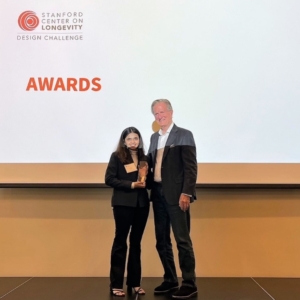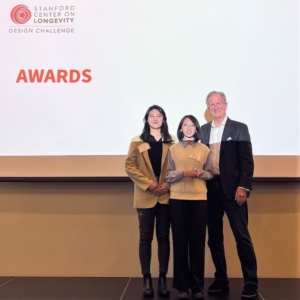Stanford Center on Longevity Announces 10th Annual Design Challenge Winners

The 1st, 2nd, and 3rd place teams holding their trophies (from left to right): Gustavo Ghavami and Carleigh McFarlane (Variable Reactive Board), Zeel Shah (Unpause Life), and Yen (Liza) Chang and Yueh-Ju (Apple) Chou (2 Care).
April 25, 2023, Stanford, CA – A mechanical device that helps people recover from injuries and maintain and develop their balancing skills won the $10,000 grand prize Tuesday in the Center for Longevity’s tenth annual design challenge.
Eight student teams from around the world flew to Stanford to take part in the competition, which is focused on finding ways to optimize health span during long lives. It was the first in-person Design Challenge competition since before the pandemic. In the decade since the challenge was launched, more than $250,000 has been awarded in prizes, and students from 69 countries have submitted more than a thousand ideas – many of which have been developed into valuable products that support healthy longevity.
This year’s prize-winning entry, created by Gustavo Ghavami from the Pratt Institute and Carleigh McFarlane from New York University, addressed the fact that balance is essential for ensuring proper musculoskeletal alignment, maintaining mobility, and optimizing health spans. The Variable Reactive Board provides a way for older people or those recovering from injury or surgery to strengthen muscles and regain and maintain balance. It can also be used by anyone at any life stage to improve balance or athletic performance.
To use the device, a person stands on a platform that pivots around its center point to shift the user’s center of gravity. The user can set the device to their specific range of motion and select a mode within their skill level. In effect, the Variable Reactive Board is to balance what the treadmill is to running, and it extends balance training to people who otherwise would be excluded. The device addresses a significant need for healthy aging. Falls among adults 65 and older caused over 34,000 deaths in 2019, making it the leading cause of injury death for that group, and the CDC recommends balance training as a key fall prevention tool.
The second-place winner, Unpause Life, aims to rectify a dearth of information about menopause for women in India. The product, a free informational and resource kit, will be given to Indian women in mid-life to increase their awareness of the changes that occur during menopause. It will also help in finding medical support for some of the symptoms that women experience during menopause. Designed by Zeel Shah from the NMIMS School of Design in Mumbai, India, the kit addresses the challenge many women face when complete information is not readily available.
Third place was awarded to an in-home monitoring device that addresses widespread periodontal issues. It was created by team 2 Care, represented by Yueh-Ju (Apple) Chou of Tunghai University and Yen (Liza) Chang from National Taipei University of Education. The tool integrates smart technology to detect whether teeth are clean and to remind users about the importance of effective oral cleaning and care. Research shows that periodontal disease greatly increases the risk of systemic diseases, such as diabetes, Alzheimer’s and cardiovascular disease. Yet dental care can be expensive and many people delay visiting the dentist. The tool can help with self-examination and direct users get treatment needed to stave off disease.
The Design Challenge competition encourages students from any university in the world to design products and services that support healthy longevity. Finalists are paid to travel to Stanford to present to an audience of academics, investors, and corporate sponsors. This year they were also able to participate in events that were suspended during the pandemic, including tours of Stanford, the Stanford d.school, the Computer History Museum in Mountain View, and an entrepreneurial workshop co-hosted by Techstars Silicon Valley.
“During these experiences, the finalists get a taste of Stanford and Silicon Valley all the while getting to know and learn from one another,” said Marie Conley-Smith who coordinates the Challenge. “We are so happy to be able to host the events in-person again, which allows the finalists to form deeper connections with those they meet.”
The connections formed during the Design Challenge were highlighted by distinguished Design Challenge alumni, who helped celebrate the 10th anniversary. They said they were affected both personally and professionally by participating.
-
- Shao Yao, whose EatWell dishware for people with dementia won the top prize in 2014, saw her product featured in the Cooper- Hewitt Smithsonian Design Museum in 2018. It is available for purchase on Amazon.
- Justin Boogaard, who competed in 2017, created an interface called GoGoGrandparent that helps seniors uncomfortable with smart phones use ride-sharing apps. It is now integrated with Uber and Lyft.
- Kyle Rand, who won 2nd place in 2017 for Rendever, which is a virtual reality platform that gives older adults shared and otherwise inaccessible experiences. Rendever can be found in senior living facilities across the US and was awarded a $2 million NIH grant to research the impact of virtual reality on the aging population.
- John Onuigbo, the 2021 winner and creator of Foris Labs, an interactive virtual science lab that allows students to conduct science experiments individually and in groups. It is designed to provide better access to education – one of the longevity supports emphasized in SCL’s New Map of Life. Since winning the Design
This year’s winners and finalists are:
FIRST PRIZE
Variable Reactive Board
Pratt Institute & NYU
A mechanical device that helps people recover from injuries and maintain and develop their balancing skills.

Carleigh McFarlane and Gustavo Ghavami receive their 1st place trophy from Stanford Center on Longevity Advisory Council Chair Russ Hill.
SECOND PRIZE
Unpause Life
NMIMS School of Design
A free informational and resource kit that will be given to Indian women in mid-life to increase their awareness of the changes that occur during menopause.

Zeel Shah receives her 2nd place trophy for her design, Unpause Life, from Stanford Center on Longevity Advisory Council Chair Russ Hill.
THIRD PRIZE
2Care
Tunghai University, Ming Chi University of Technology, and National Taipei University of Education
An in-home monitoring device that addresses widespread periodontal health-care issues.

Yen (Liza) Chang and Yueh-Ju (Apple) Chou receive their 3rd place trophy for their design, 2 Care, from Stanford Center on Longevity Advisory Council Chair Russ Hill.
FINALISTS
-
- Circle Fun (Beijing Institute of Technology, China) – Public fitness equipment designed for use by grandparents and grandchildren together.
- PaperRoad (Carnegie Mellon University, USA) – An AI-powered wellness platform for teens targeting mental health.
- Shakti (UC Davis, USA) – An app for pregnant women that detects anemia, monitors iron-folic acid (IFA) intake, and provides information about anemia symptoms and treatment.
- Sonura (University of Pennsylvania, USA) – An auditory system for NICU babies that blocks high frequency environmental noises and plays parental audio messages to promote healthy development.
- Tree of Life (NMIMS School of Design, India) – A board game that helps people understand the cognitive changes associated with healthy aging and the steps they can take to maintain cognitive health.
SPONSORS
The challenge is made possible by generous sponsorship from a number of companies and foundations. Lead sponsorship is provided by Target, Honda, and Finance of America Reverse. Additional financial support has been provided by Procter and Gamble, Halbert Hargrove, Eskaton, Odyssey Group Coaching LLC, and Tushara Dilanie.
JUDGES
Jeremy Chang, Director, Asset Acquisition; Associate Director, Computational Genetics, BridgeBio
Michael Fredericson, Professor of Orthopedic Surgery; Program Director, Lifestyle Medicine; SCL Co-Director, Stanford University
Riley Gibson, President, Silvernest
Deborah Kado, Professor of Medicine; SCL Co-Director, Stanford University
Todd Murch, President & CEO, Eskaton
Jane Nakagawa, Vice President of R&D, American Honda Motor Co., Inc.
Sha Yao, CEO & Chief Designer, EatWell
About the Design Challenge
The Stanford Center on Longevity Design Challenge is a global competition aimed at encouraging students to design products and services to improve the lives of people across all ages. Established in 2013, the Challenge is focused on ways to motivate and empower people in their daily lives both inside their homes and in their community, particularly as they remain healthy and vigorous long past the traditional beginning of retirement.
For more information, visit http://designchallenge.stanford.edu
About the Stanford Center on Longevity
The mission of the Stanford Center on Longevity is to redesign long life. The Center promotes the acceleration and implementation of scientific discoveries, technological advances, behavioral practices, and social norms so that century-long lives are healthy and rewarding. Founded in 2007 by Laura Carstensen, PhD and Thomas Rando MD, PhD, the Center works with more than 150 Stanford faculty, their students and research staffs, as well as leaders from industries, thought leaders, and policy makers to develop workable solutions for urgent issues confronting the world as the population ages. For more information, visit http://longevity.stanford.edu
Follow the Stanford Center on Longevity on LinkedIn, @StanfordLngLife on Twitter, and via our Facebook page for more updates – including announcements on “Designing for Life Transitions,” the theme for the 2023-2024 Design Challenge.
For press inquiries, please contact: David Pagano, Communications Director ([email protected]).
